The fast-growing world of B2B SaaS requires an optimized RevOps strategy more than a good sales team or a smart marketing campaign to fit the current needs of continuous adaptation. The best in the business are now polishing their strategies while incorporating new technologies so as to remain on top.
We recently spoke to Shantanu Mishra on this topic. Shantanu is the Senior Vice President, Revenue Strategy and Operations at Pluralsight and an accomplished leader with over 20 years of RevOps experience, who has spearheaded transformations at multiple organizations.
From setting the right operating rhythms to leveraging AI for strategic decision-making, Shantanu offers some actionable advice for businesses striving to optimize their RevOps functions and achieve sustainable growth.
This guide, based on Shantanu’s expertise, outlines critical strategies and practical insights that large-scale SaaS companies can use to build an effective and scalable RevOps function.
You can watch the conversation below.
Laying the Foundation for RevOps Success
As companies aim to expand their functions, the focus comes on the integration of all disparate teams towards a common goal. But the primary objective should be to give a relevant definition to Revenue Operations for your business and subsequently develop a roadmap that works the best for you based on your company size and stage.
Second stage of the journey rests upon customer relationship management which necessitates the importance of having a robust onboarding process and a seamless experience for all the stakeholders.
But just the implementation of the aforementioned processes is not sufficient; these aspects need to be thoroughly thought out and integrated to the whole company strategy so that there is no disarray and all units. Sales, marketing and customer success must be forming and pulling the same rope.
Having a right RevOps team that not just gathers these metrics but also implements them strategically makes the whole process a lot smoother. That entails having experts who specialize or have a generalized approach to the task at hand; strategists, data experts, process people and people who create and execute engagement.
Related Post: Building a Successful RevOps Roadmap: A Starter GuideThis outlines the importance of having a robust cross department alignment and balancing horizontal and vertical functions seamlessly which bring us to an important point of how to hit the mark when it comes to cross alignment.
The Strategic Importance of Alignment Across Departments
For every RevOps strategy to succeed, one must first align siloed functions of Sales, Marketing and Customer Success. Misalignment tends to cause inefficiencies, fragmented customer experiences and missed revenue opportunities. Unifying strategies helps firms realize all-round improved results.
Step 1: Get Everyone on the Same Page
a. Sales and Marketing Alignment
Crucially, there has to be a smooth communication between the sales and marketing teams. The idea here is that the marketing should strategically produce content that facilitates the sales process. By generating leads for Sales which are already highly engaged and pre-qualified, you can substantially reduce the sales cycle time as well as improving conversion rates.
b. Customer Success as a Core Revenue Driver
Customer Success must form part of your RevOps strategy if you want to sustain relationships and diminish churn rates. It will not work where Customer Success teams do not liaise with either the Sales or Marketing department since these other two departments make efforts aimed at bringing value to customers in all stages of their journey
Step 2: Proceed with a Unified RevOps Strategy
After getting everyone on the same page, the next step is to introduce an all inclusive RevOps approach. This would enable every department in your company such as customer success, marketing team and sales working towards one goal.
a. Single Point of Truth
It is important to buy into centralized platforms that give every single employee a chance to access and interrogate aggregated information. This kind of truth not only eliminates discrepancies but also encourages decision-making based on facts with different teams operating with full knowledge about user behavior and pipeline health.
b. Process Standardization and Handoffs
Clearly defined processes and smooth handoffs between teams are the backbone of an efficient RevOps function. Through this, each member of the team knows his/her role in the customer journey; hence ensuring consistent execution across all teams leading to higher revenues .

Building a Stellar RevOps Team
Lack of trust and poor transparency are the main obstacles to effective leadership, especially at the VP level and above. In fostering a culture where team members can be genuine, cultivate trust, creating an open and safe environment for individuals to share their thoughts freely with each other and breaking apart the siloes is paramount. Trust is even more significant in RevOps since it demands alignment across multiple roles.
1. Hiring the Right Skills
Having a solid RevOps team can make or break your RevOps strategy and can potentially propel your business to new heights. By having a unified revenue engine, all the members of the organization can ensure cohesion across departments while hiring new talents. Teams can implement a horizontal function to get an end-to-end view of the funnel. With proper investment planning and data enablement, hiring can be optimized better.
For a complete and holistic team, the talents can be demarcated across four major buckets
a. Athletes
These are versatile team members who can juggle multiple roles and can wear different hats when required.
b. Builders
The specialists who excel in crafting and perfecting systems. They are your go-to people when it comes to building a process from scratch.
c. Strategic Thinkers
Professionals with a knack for strategic planning and data analysis.The have attention to details and can come handy while taking an analytical approach.
d. Financial Acumen
These are the individuals adept at managing the financial aspects of operations to ensure profitable scaling.
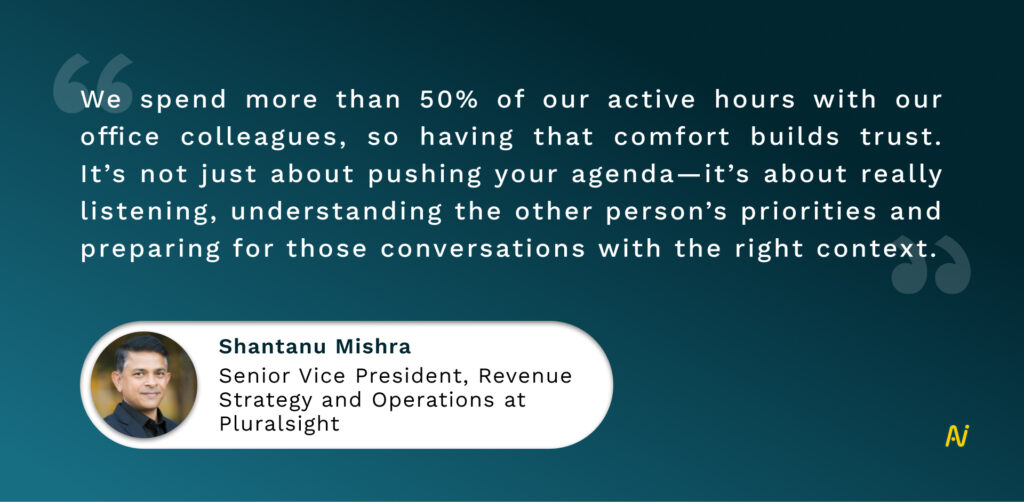
2. Critical Attributes for RevOps Talent Acquisition
To create a highly performing RevOps team, it is important to acquire talents in that area. Key traits organizations should look for:
a. Data-driven Decision-making
For RevOps data-driven decision making is key. Find candidates who can easily interpret complex datasets due to strong analytical skills.
b. Cross-functional Experience
To communicate with sales, marketing, and customer success departments effectively, leaders of RevOps should have cross domain experience.
c. Strategic Vision
You need leaders who can manage your day-to-day activities while planning for the long term as you expand your RevOps function.
Recruiting strategic thinkers along with operational experts assures growth objectives are met by the RevOps squad in addition to delivering immediate results.
Company Maturity Based Customization of RevOps Roles
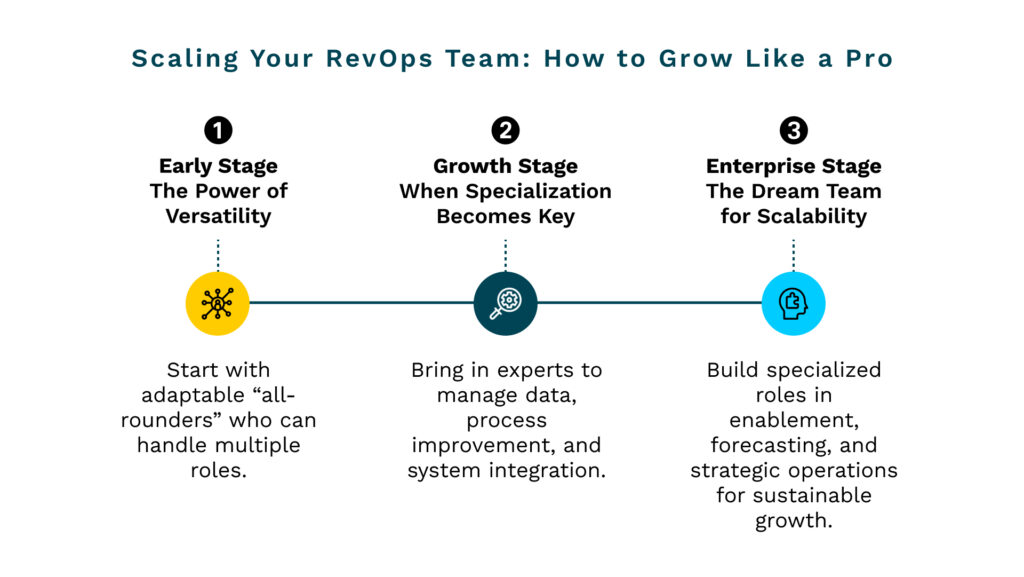
1. Company Stage
Growth stage is the only thing you can depend on when it comes to building a powerful Revenue Operations team. How to fit your RevOps strategy into the organizational maturity:
a. Early Stage (0-10M ARR)
In this phase, being flexible is important. Get individuals who are versatile “all-rounders” that can perform multiple roles, like managing basic CRM systems and streamlining sales procedures.
b. Growth Stage (10-100M ARR)
As your company grows bigger, things get more complex. At this point, start including functionally specialized positions such as data analysts, process improvement experts as well as system integrators.
c. Enterprise Stage (100M+ ARR)
The transformation calls for a solid and capable RevOps team with specific job descriptions across data, enablement, forecasting, and strategic operations within large corporations. Leadership changes its focus to scalability which means that while maintaining excellence in day-to-day operations, managers should also think forward.
2. Horizontal vs Vertical Functions – Organizational Design
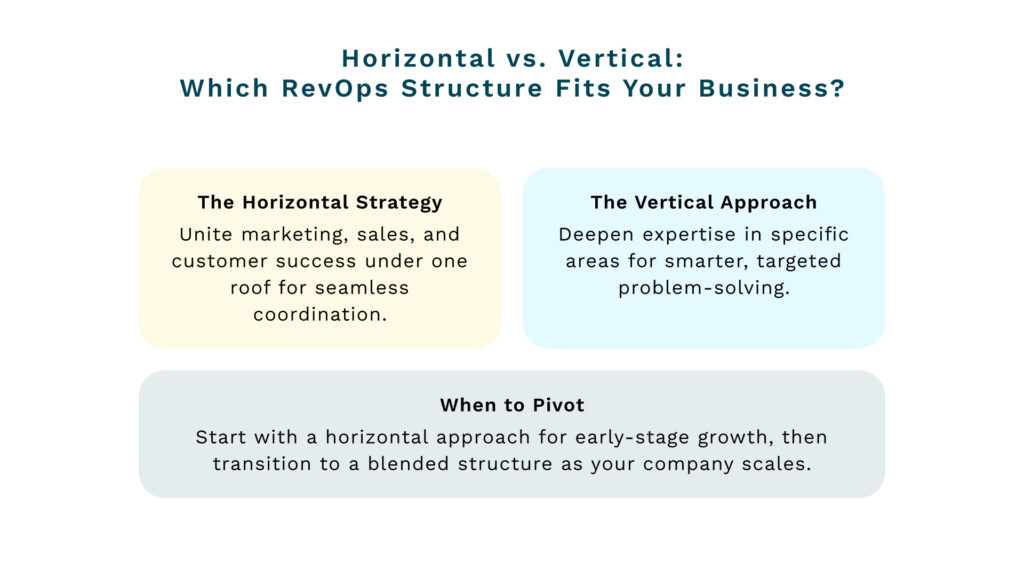
A good RevOps structure would strike the right balance between horizontal and vertical functions.
a. Horizontal Alignment
Uniting activities conducted by sales people, marketers or customer success officers around one center ensures that information flow is consistent; similarly all processes are carried out consistently and there are clear structures for record keeping and decision making.
b. Vertical Specialization
Deepening capabilities within each area like having separate teams for sales enablement or customer success operations allows for real expertise in certain areas of concern plus intelligent approach to issues at hand.
The choice between these structures depends on the scale and intricacy of your organization. At the beginning, have an integrated horizontal function before changing into a mixture model that suits your needs as they grow.

Securing Revenue Streams that are Sustainable
In an ever evolving marketplace, it is critical to have sustainable sources which are also steady. This underscores the importance of going beyond short-term financial goals – it is more about the long-term planning of revenue retention and growth. In outlining how best to leverage this, and at the same time, optimize every process around your revenue streams, teams must prepare the ground for forecasting growth and success.
Here is how this can be achieved:
1. Process Optimization to Maximize Revenue
To attain the highest potential of your revenue, the need to optimize every stage is more crucial than before. By leveraging effective optimization, teams can smoothen their workflows, increase operations and enhance overall efficiency.
Lead-to-Revenue Optimization: Eliminate friction by continuously refining lead-to-revenue process. Clearly define your Marketable Leads (MQLs) and Sales Qualified Leads (SQLs) to ensure smooth conversions between teams and reduce potential dropouts. You can also utilize your performance data to perform a pipeline health check.
Structured Upsell and Cross-Sell Playbooks: A lot of revenue comes from customers you already have. To do this well, you need defined playbooks on how to upsell and cross-sell. RevOps can help based on customer data, account segmentation, and lifecycle stages – identifying when it makes sense to introduce more value, without trying to sell for selling’s sake.
2. Bow Tie Structure for an Effective RevOps Strategy
Bow tie model is a strategic framework that emphasizes on balancing pre-sales and post-sales activities to drive increased customer satisfaction. It enables the visual representation of customer lifecycle alignment in order to optimize overall revenue operations.

It consists of three sides:
a. Pre-Sale Focus:
On the left side of the bow tie, there are activities before selling such as lead generation or qualification as well as the sales process. In this case, effective RevOps strategies ensure that these activities are among others marketing and sales teams collaborating together leading to conversion of leads into customers efficiently.
b. Post-Sale Focus
The right hand side of a bow tie includes such things like migrating customers, helping them support and up-sell products. Thus, from sales to post-sale functions still maintain customer engagement throughout while creating long term relationships.
c. Central Hub
The central part of the bow tie represents data at its core which serves as a central point for pre-sales and post-sales activity connection. Therefore, it will provide all parties with similar data sources and insights hence coordinated action plans towards revenue generation
For effective use of bow tie model:
a. Integrate Data & Processes
Data from before sale activities and after sales must have one source. This enables one to see the entire journey made by the client thereby making better judgments.
b. Continuous Feedback Loops
Improve processes utilizing feedback loops between the sales team and post-sales service as well as identify gaps in customer experience.
c. Overall Customer View
Accordingly, Bow Tie modeling should help create an overall customer view that reflects all interactions with touch points optimized to increase satisfaction levels resulting in higher revenues.
Predictive Analytics and Accurate Revenue Forecasting
Predicting revenue is vital in determining how much you will make and what actions you need to take. This is even more crucial in this sector as the ability to predict sales revenues and adjust the data gives one an edge over other players.
a. Data Driven Models for Revenue Forecasting
The accuracy of resource allocation and strategic planning depends on the right forecast. Such forecasts help RevOps teams understand expected changes in their business environment thus enabling them prepare for different scenarios as well as optimize their strategy.
b. Optimizing Your Pipeline with Sales Velocity Analysis
Sales velocity measures how fast deals move through your pipeline. Therefore, by analyzing it, RevOps can identify bottlenecks, streamline sales processes and ensure that deals keep moving at a rapid rate.

c. The Right Operating Rhythms for a RevOps Strategy
No RevOps strategy is complete without a deliberate cadence to follow for tracking and reviewing key performance indicators (KPIs). An operating rhythm entails the frequency at which a company evaluates its performance and adjusts its strategies.
Successfully establishing an appropriate operating rhythm requires balancing various review periods so as to offer a holistic view of the health of a business. The aim is that all information shared during these reviews should be meaningful and actionable.
The term “buckets” is how Shantanu describes KPIs in terms of how they should be handled:
a. Weekly Reviews
These are essential to keep tabs on immediate Key Performance Indicators (KPIs). Weekly reviews should focus on metrics that require real-time attention and action. This includes daily operational metrics and short-term performance indicators.
b. Quarterly Reviews
Quarterly assessments should be conducted on more stable metrics such as unit economics or overall financial health since it is easier to see certain costs and revenue patterns over longer periods. For example, unit economics might look skewed in their first month but stabilize by the end of the quarter.
c. Monthly Reports
Monthly reports need not include lengthy meetings for team members, but they must summarize performance highlighting key trends and insights.
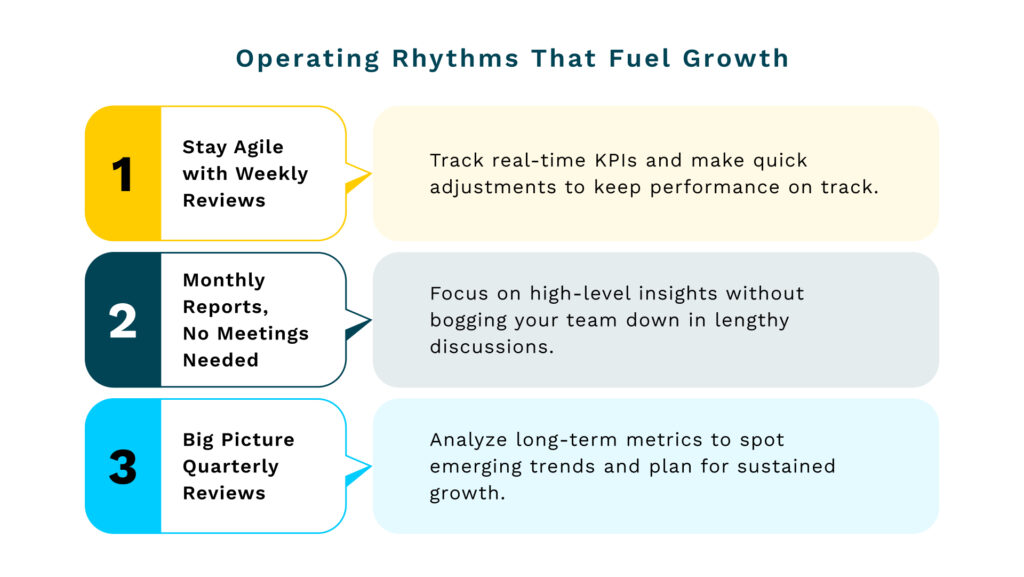
The key to successful operating rhythms, according to Shantanu, is balancing the need for data with the practicalities of execution.
Leverage Technology: Building a RevOps Tech Stack That works
Building on RevOps functions at an enterprise level rests upon a right mix of tools and technology to propel your efforts forward. The core ones include:
a. Strong CRM System
Your RevOps will run like clockwork with a good CRM System. It streamlines all customer interactions, hence ensures accuracy and accessibility of data. Additionally, the effective CRM enables easy monitoring of sales activities and clients’ touch points thus providing a 360 degree view of the entire customer lifecycle.
b. Intelligent Revenue Platforms
Accessing real-time insights becomes necessary as companies grow. In this case, revenue intelligence platforms provide in-depth analytics on pipeline health, client behavior, and deal progression. The team’s decisions are powered by such insights thus driving growth of revenue.
c. Automation & Seamless Integrations
Automate repetitive tasks and integrate every tool into your tech stack so that there are no silos. This saves time, reduces human errors and keeps teams consistent with the right information.
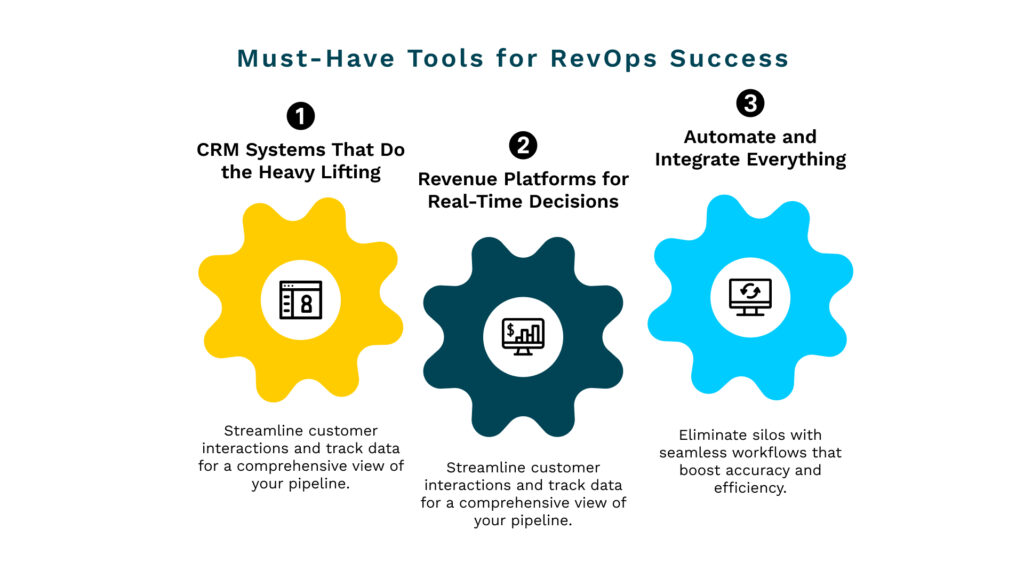
Data-Driven Decision-Making for Continuous Improvement
Data is the lifeline for RevOps. However, many organizations have siloed data making it difficult to provide consistent reports and have aligned strategies. To avoid this, organizations must invest in a strong data infrastructure that consolidates information from different departments. This way, all teams are on the same page leading to combined efforts and coherent decision-making.
1. Data Cleanliness in a RevOps Strategy
The quality of your data is highly significant if you need to depend on it for making decisions based on the relevant data. Consequently, data audits and cleansing should be done from time to time in order to ensure accurate actionable insights.
2. Advanced Reporting and Real-Time Dashboards:
This allows teams to spot trends quickly and act accordingly due to real-time dashboards which give an instant view of key revenue metrics. With detailed reporting structures in place, you can have a holistic overview of your business health starting from CAC to LTV; hence monitoring everything about customer acquisition costs (CAC) up to lifetime value (LTV).
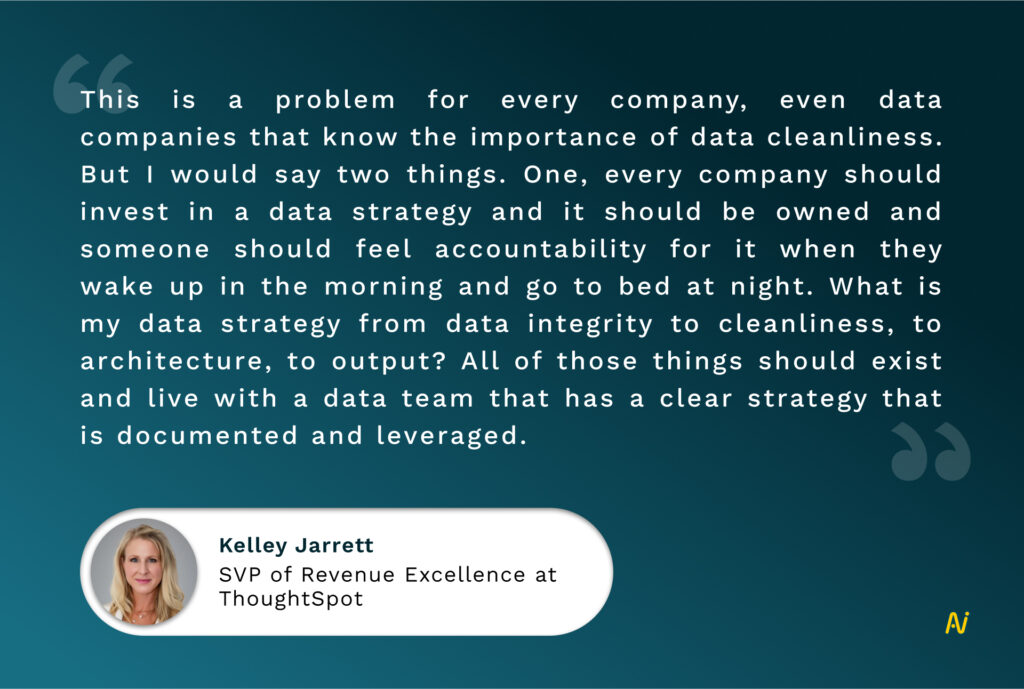
To understand the deal dynamics better, It’s important to gather information on a daily basis while doing intensive studies at the end of every three months. This way you are able to get a firm grasp on the emerging trends and use them for deeper analysis.
Competent RevOps teams monitor various revenue metrics to improve performance during each stage of customers’ journey.
Some of the Important metrics to track include:
| Customer Acquisition Costs (CAC) | It is the amount of money needed to acquire new customers |
| Conversion Ratio | Tracks the number of leads who move through the sales funnel. |
| Cost per Acquisition (CPA) | A parameter used to determine how economically customers are acquired. |
| Long-Term Value(LTV) | For understanding customer value over time and strategic investment decisions. |
| Renewal and Expansion Rates | Important measures for post-sales excellence and driving revenue increase. |
Strategic Planning and Adaptability for a Sustainable RevOps Strategy
Building sustainable growth requires more than short-term wins; it demands a robust strategy that can adapt and scale over time. Revenue Operations RevOps plays a crucial role in this, acting as the engine that drives long-term growth. Success lies in fostering a balance between strategic planning and adaptability, allowing businesses to remain agile as markets shift and customer needs change.
1. Planning and Adaptability for Sustainable Growth
RevOps is not about short term wins but rather about creating engines of growth which can be sustained and scaled by a company.
a. Regular Strategic Reviews and Adjustments
As markets change and customer needs evolve, your teams must regularly evaluate the RevOps strategy. This can help you sense the winds of change in your industry as well as tweak tactics at times.
b. Building Flexible and Scalable Processes
The processes that you build today should be flexible enough to grow along with the business. By making frameworks instead of being bound by rigid structures, you maintain agile RevOps functions that quickly adapt to new challenges.
2. Tracking the Right Metrics for a optimised RevOps Strategy
Measuring RevOps KPIs is all about selecting those that show both immediate performance levels and long term viability.
Related Post: The Ultimate Guide to RevOps Metricsa. Customer Lifetime Value (CLV) and Churn Rate
These are two of the most critical metrics with regard to any SaaS enterprise. Increase in CLV while reducing churn is the secret behind sustainable development. Making sure your RevOps strategy understands what influences this is vital too, whether it’s driving factors like this or improving them.
b. Sales Efficiency Ratios
A measure for assessing how good your revenue operations are through their efficiency metrics like LTV/CAC ratio. Having a healthy ratio implies efficient revenue strategies while having a poor one means there is a need for optimization.
3. Win-Loss Analysis: The Magic Bullet in Strategic Decision Making
One of the most underused yet mighty tools in RevOps is win-loss analysis. It is an effective cornerstone of a RevOps strategy that helps in uncovering insights on why deals are won and lost. Hence, providing vital market dynamics and competitive positioning insights.
Organizations can refine their sales strategies, optimize processes, and ultimately drive better outcomes by systematically analyzing wins and losses.
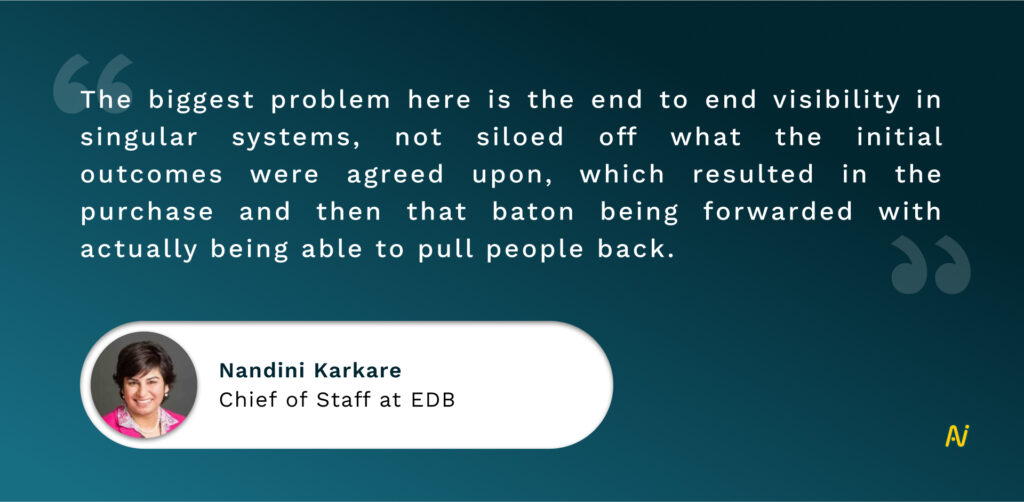
Some factors to effective win-loss analysis are as follows:
1. Knowing Your Competition
Always evaluate who you’re beating on a regular basis. Do you win because of superior product features, pricing or customer experience?
2. Listening to the Field
The sales teams and customer success teams should have field training to be able to decode essential insights. This feedback loop is essential for capturing nuanced causes for the deals not being closed.
3. Being Proactive
These cases must be identified and acted upon immediately in case of unusual occurrences like increased discounting or reduced win rates.
RevOps leaders can use such insights to fine-tune their strategies and modify enablement programs accordingly, which will arm their teams with as much up-to-date information as possible to replicate more successfully but lose less often in turn
Here is an elaborate way of conducting a win/loss analysis.
4. Daily Data Collection and Quartely Analysis
To understand the deal dynamics better, It’s important to gather information on a daily basis while doing intensive studies at the end of every three months. This way you are able to get a firm grasp on the emerging trends and use them for deeper analysis.
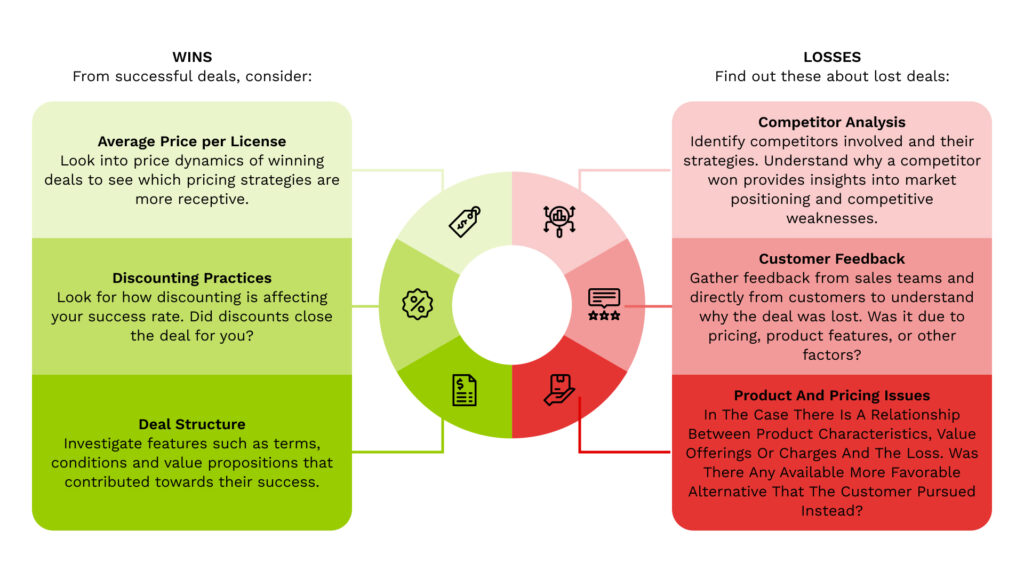
a. A Proactive Issue Identification
It is very important to be on the lookout for any abnormality or pattern which could indicate problems below the surface. Addressing these issues early can stop them from escalating as well as affecting performance.
b. Unusual Discounting
If the discounting pattern is noticeably different and increasing at an unusual rate, the leadership must be brought into the picture immediately. This may suggest latent issues with pricing strategies or deal structures that need attention.
c. Low Win Rates
If your win rates are lower than expected, there must be some looming cause that needs to be investigated. Are there common factors driving these losses? The sooner you identify them and take a necessary course of action, the faster you can refine your approach.
RevOps teams should identify and address challenges ahead of time in order to make timely corrections and improve overall performance.

AI Overhauling RevOps Through Emerging Technologies
Any dialogue about the future of RevOps without mentioning artificial intelligence (AI) would be incomplete. Shantanu mentions that AI is on the verge of substantially transforming RevOps by developing opportunities beyond mere task automation and better email targeting.
There are some AI solutions that are already providing positive results:
1. Identifying Ideal Customer Profiles (ICPs):
It can also help sales teams find them faster by analyzing large datasets. By using social media and other sources of information, AI can identify potential customers who match the ICP criteria. This makes sales efforts more efficient.
2. Intent Data:
AI makes it possible for teams to get in touch with prospects who have been showing interest in your products. It acts as early indications of potential customers looking for answers. Such a prediction system facilitates proactive outreach hence boosting GTM (go-to-market) approaches.
3. Early Warning Systems:
Moreover, AI can act as an advance warning system to detect when customer behavior or market conditions change before they become major problems. As an example, if a competing company starts making headway with your main clients, AI will be able to spot this trend early enough.

As AI continues to evolve, it will unlock even more sophisticated use cases, such as predicting shifts in the competitive landscape or analyzing market signals faster than ever before. The potential is enormous, and RevOps leaders need to be at the forefront of adopting these technologies.
Optimize your RevOps Strategy with Nektar
A strong RevOps foundation should also be in place and ready to evolve to achieve organzational success. Shantanu Mishra and other professionals in the field have pointed out that cooperation between functional units, data consolidation and assistance from AI are essential for competitive advantage.
This is where Nektar can help.
With Nektar, you can drive RevOps efficiency with trusted CRM data. You can:
- Improve accuracy of opportunity reporting.
- Automate (and configure) contact & opportunity role creation
- Understand quality of activities at scale
- Capture data of the entire GTM team
See How Signifyd Rectified Their Data Gaps to Achieve Revenue Excellence With NektarInstead of making an effort to catch up with the fast-moving competition, become the one who dictates the pace. Discover how Nektar can change your RevOps strategy and help your organization become truly sustainably growing. Let’s cover how we can help you in these areas. Contact one of the experts today!








